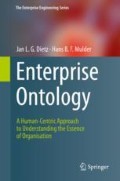Abstract
The TAO theory (Τ-theory), or function-construction theory, is a theory about the way subjects (people) perceive the things that surround them. TAO stands for Teleology, Affordance, Ontology. The foundations part starts with an excerpt from Gibson’s theory of affordances. This theory clarifies the being subjective of affordances. Next, the intended affordances, commonly called functions, of designed things (artefacts) are discussed. Although people are mostly and primarily interested in the functions (affordances) that things may offer them, engineers are also interested in the construction of things. Contrary to function, construction is an objective notion. Related to function is the notion of experience, defined as the sensation that an affordance evokes in someone’s mind. Based on it, the notion of value is discussed as the intensity of experience, measurable on an ordinal scale. The elaborations part starts with a discussion of constructional models and functional models, their incommensurability, and the fundamental difference between constructional decompositions and functional ones. Next, these findings are illustrated to an example of an enterprise.
Access this chapter
Tax calculation will be finalised at checkout
Purchases are for personal use only
Preview
Unable to display preview. Download preview PDF.
References
Kant, I. (1965). First introduction to the critique of judgment (The Library of Liberal Arts) (p. xv, 55). Indianapolis: Bobbs-Merrill.
Nagel, T. (2012). Mind and cosmos: Why the materialist neo-Darwinian conception of nature is almost certainly false (p. x, 130). New York: Oxford University Press.
Rosenblueth, A., Wiener, N., & Bigelow, J. (1943). Behavior, purpose and teleology. Philosophy of Science, 10(1), 18–24.
Guarino, N., Oberle, D., & Staab, S. (2009). What is an ontology? In Handbook on ontologies (pp. 1–17). Berlin: Springer.
Guizzardi, G. (2005). Ontological foundations for structural conceptual models. CTIT, University of Twente.
Simons, P. (1987). Parts—A study in ontology. New York: Oxford University Press.
Gibson, J. J. (1979). The ecological approach to visual perception (p. xv, 332). Boston: Houghton Mifflin.
Chemero, A. (2003). An outline of a theory of affordances. Ecological Psychology, 15(2), 181–195.
Dietz, J. L. G. (2012). Red garden gnomes don’t exist. The Netherlands: Sapio Enterprise Engineering. www.sapio.nl
Dietz, J. L. G. (2009). Architecture: Building strategy into design. The Hague: SDU Publishing.
Yourdon, E. (1989). Modern structured analysis (p. x, 672). Englewood Cliffs, NJ: Yourdon Press.
Mannaert, H., Verelst, J., & Bruyn, P. D. (2016). Normalized systems theory: From foundations for evolvable software toward a general theory for evolvable design. Kermt: Koppa.
Lehman, M. M., & Belady, L. A. (1985). Program evolution: Processes of software change (A P I C Studies in Data Processing) (p. xiii, 538). London: Academic.
Puett, M. J. (2016). The path: What Chinese philosophers can teach us about the good life (First Simon & Schuster hardcover edition, p. xvi, 204). New York: Simon & Schuster.
Hoogervorst, J. A. P. (2017). Ideological foundation. In Foundations of enterprise governance and enterprise engineering: Presenting the Employee-Centric Theory of Organization (pp. 355–564). Cham: Springer.
Author information
Authors and Affiliations
Rights and permissions
Copyright information
© 2020 Springer Nature Switzerland AG
About this chapter
Cite this chapter
Dietz, J.L.G., Mulder, H.B.F. (2020). The TAO Theory: Understanding Function and Construction. In: Enterprise Ontology. The Enterprise Engineering Series. Springer, Cham. https://doi.org/10.1007/978-3-030-38854-6_7
Download citation
DOI: https://doi.org/10.1007/978-3-030-38854-6_7
Published:
Publisher Name: Springer, Cham
Print ISBN: 978-3-030-38853-9
Online ISBN: 978-3-030-38854-6
eBook Packages: Computer ScienceComputer Science (R0)

